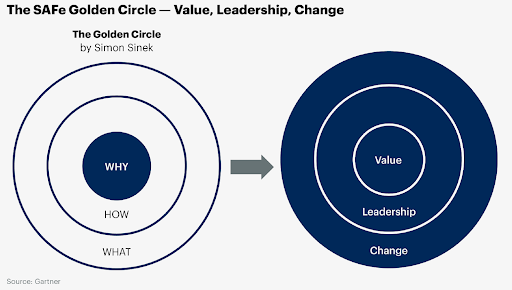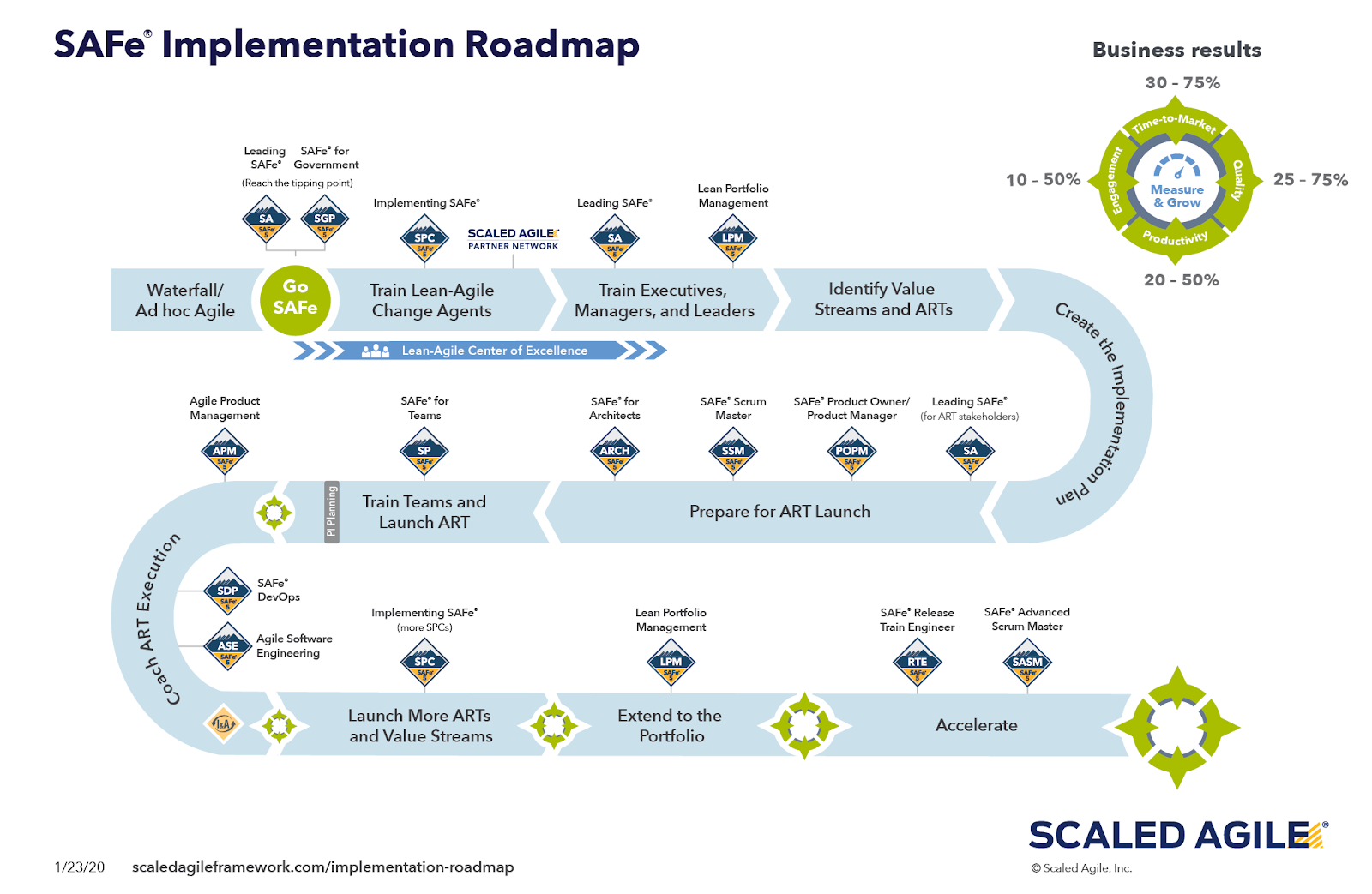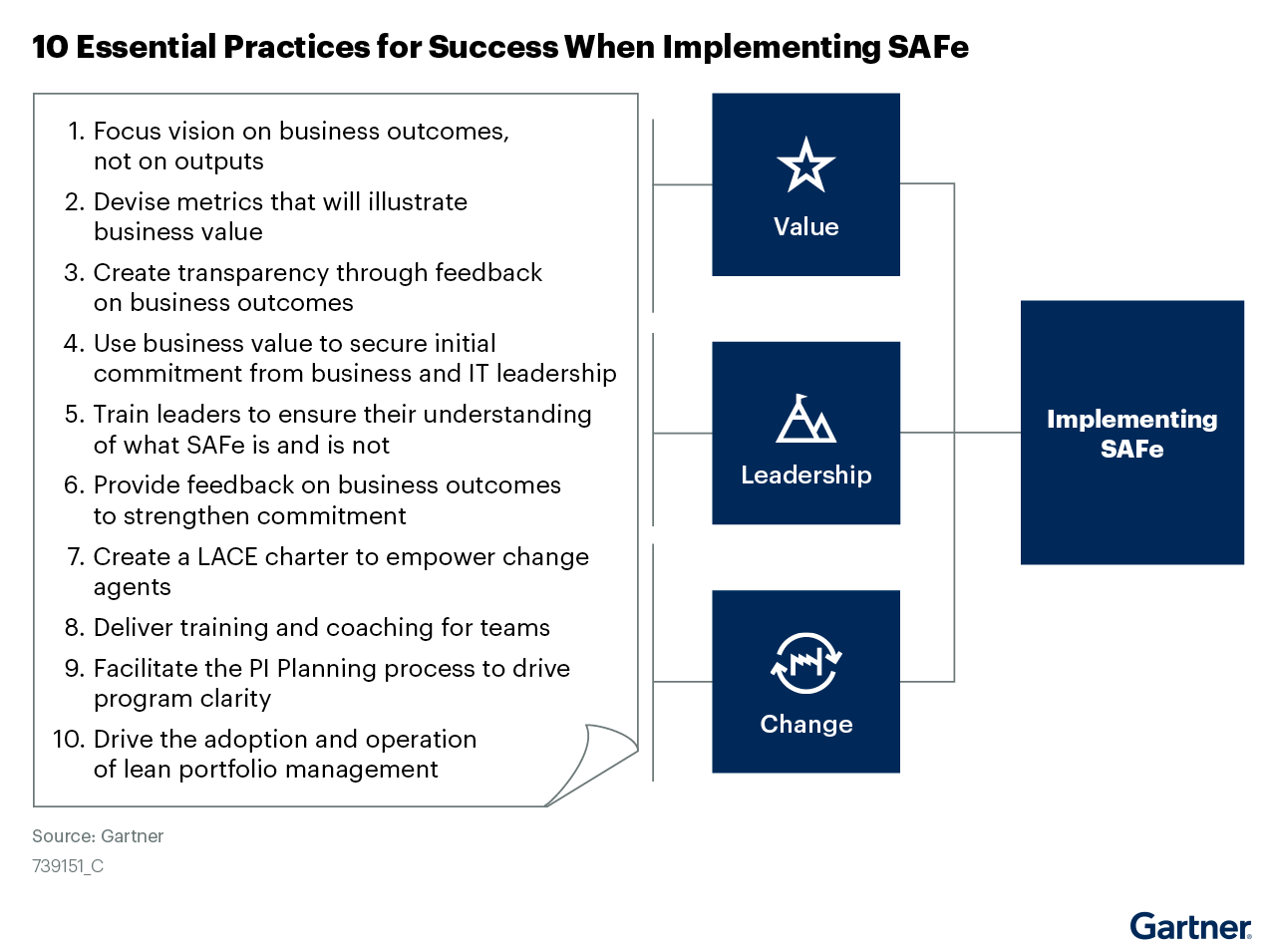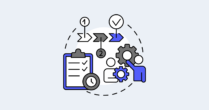Businesses need to be quick and flexible. SAFe Agile, or the Scaled Agile Framework, is a way to do this. It’s perfect for product managers and project managers in a large organization.
What is Agile methodology?
Agile is a way to manage projects that’s different from the old ways. It doesn’t follow a set plan from start to finish. Instead, it breaks the work into smaller parts called “sprints.” An Agile team works on these small parts one at a time. This lets them change things quickly and keep improving.
Why do businesses like Agile?
Businesses like using Agile because it has many benefits:
- Better products: teams can find and fix problems early. This makes the final product better.
- Happy customers: when customers give feedback during the project, they feel included in the process. They know their opinions matter.
- Happy teams: teams like Agile because they get to collaborate. Product, engineering, design, marketing, and others can all work together and affect decisions. This gives them structure and a sense of ownership.
- Faster to market: products get finished faster, which means they can be sold sooner. This is good for beating competitors.
Agile also helps manage risks. When an Agile team breaks down a project into smaller chunks, they can adjust to the market conditions faster.
Agile methodology keeps everyone aware of how the project is going. This visibility into the big picture creates transparency.
Finally, Agile principles encourage teams to look for ways to improve. This type of “lean thinking” creates a continuous learning culture.
What is SAFe Agile?
SAFe Agile is a way to use Agile in a large organization. It combines Agile with other innovative business ideas. This helps large companies work faster, better, and more predictably. It also minimizes stagnation and ensures continuous delivery of new products and features.
SAFe Agile is great for complicated projects requiring many teams to work together. It helps all of these teams go in the same direction, which is why large organizations find it useful.
The main ideas of SAFe Agile
SAFe Agile has ten main ideas. Let’s break these down in plain English.
- Economic view. Make decisions considering their economic impact. Ask yourself – what brings the most value to my business?
- Systems thinking. See how everything is connected. Understand that changing one part of the system affects the whole system.
- Assume variability. Preserve options. Keep your options open. Be ready to adjust your plans as you learn more and as things change.
- Build incrementally with fast and integrated learning cycles. Develop in small steps. Test your work quickly and learn from it to improve.
- Base milestones on objective evaluation of working systems. Measure your progress by testing real, working parts of your project, not just by plans or theories.
- Visualize and limit work-in-progress. Reduce batch sizes. Manage queue lengths. Keep your work visible and limit how much you take on at once. Work in smaller batches and keep an eye on the work lineup.
- Apply cadence. Synchronize with cross-domain planning. Work in a steady, predictable rhythm. Plan together with other teams to stay aligned.
- Unlock the intrinsic motivation of knowledge workers. Encourage and support your team’s natural drive to do good work. Create an environment where they can succeed and feel valued.
- Decentralize decision-making. Give teams the power to make important decisions themselves. This will accelerate your product development.
- Organize around value. Focus on what gives value to your customers. Arrange your teams and work around delivering that value efficiently.
Let’s explore SAFe Agile a little more. How does it actually work in practice?

How SAFe Agile works
SAFe Agile has four levels:
- Team level: small software development groups work together in sprints to make parts of the product
- Program level: a development team works together on big goals
- Large solution level: this is for very big projects. It organizes many teams and suppliers
- Portfolio management: this level matches big company plans with an implementation roadmap
Let’s examine each level in more detail.
Team level
At the team level, small software development groups work together in sprints. Sprints are short consistent cycles of work. Each sprint focuses on creating a specific part of the product.
These teams often use Scrum or Kanban methodologies. They apply Agile principles to manage their tasks and collaborate effectively.
The goal is to produce a potentially shippable product increment at the end of each sprint. Using SAFe Agile here opens up the doors for feedback and continuous progress
Program level
This level is about multiple teams working together towards larger, more complex goals. It’s where individual team efforts are aligned and integrated.
The Program level is typically organized around an Agile release train (ART). This is a long-term repeatable framework for delivering value at scale.
All team members come together for regular planning meetings called PI (Program Increment) planning. The goal is to:
- Align on goals
- Discuss dependencies
- Plan the next set of features to develop
Large solution level
Very large and complex projects sometimes require coordination across multiple ARTs or suppliers. This is where the large solution level comes in. It provides the necessary structure and processes.
The goal is to align multiple ARTs that are working on different aspects of a large solution. You need to ensure they are in sync and integrated.
A critical component of this level is the solution intent. This living document captures the evolving understanding of the solution being built. It includes requirements, design, and other critical information.
Portfolio management
At this level, SAFe aligns the organization’s main themes and objectives with implementation. Overarching vision and large-scale planning occur here.
Portfolio management involves:
- Allocating budgets to various value streams
- Ensuring governance and compliance
- Creating and maintaining a portfolio roadmap
- Providing a high-level view of the organization’s plans and progress over time

SAFe Agile compared to other methods
SAFe Agile is different from other methods. It covers everything from small teams to big company strategies. This makes it a complete guide for big companies. Let’s explore how SAFe Agile is different from other popular frameworks and methodologies. We’ll look at:
- Large Scale Scrum (LeSS)
- Nexus
- Scrum
- Kanban
Note: there are many more approaches out there. We selected the most popular ones.
| Aspect | SAFe Agile | LeSS | Nexus | Scrum | Kanban |
|---|---|---|---|---|---|
| Scope | Covers all levels: team to portfolio | Focuses on scaling at the team level | Similar to LeSS, focuses on team scaling | Mainly for single teams | Flexible, suits teams or whole organizations |
| Lean Integration | Strong emphasis on lean principles | Lean thinking present but less emphasized | Lean ideas included, not as central | Not explicitly Lean-focused | Strong Lean principles, focuses on flow |
| Organizational Alignment | Excellent for whole-company alignment | More team-centric, less on whole company | Team-centric alignment | Focuses on individual team effectiveness | Adaptable, can align teams to organizational goals |
| Roles and Structure | Defined roles and structured approach | Flexible roles, less structured | Flexible roles, similar to LeSS | Defined roles, less structured than SAFe | No defined roles, highly flexible |
| Customizability | Multiple configurations for different needs | One main framework, less customizable | One main framework, similar to LeSS | One core framework, adaptable | Highly adaptable to context |
| Focus on Improvement | Strong on continuous learning at all levels | Focuses on team improvement | Team-focused improvement | Continuous improvement within teams | Emphasizes continuous improvement and flow |
| Adoption and Community | Widely adopted, especially in large enterprises | Popular, but less so in very large organizations | Less adopted than SAFe and LeSS | Highly popular and widely adopted | Growing adoption, popular for its flexibility |
Now that we understand the difference, SAFe Agile might seem like a very attractive approach. If so, keep reading. We’ll explain how you can implement this approach into your everyday software development and beyond.
Real-world examples of SAFe Agile transformations
Example 1: Philips
Philips is a leading health technology company. Coordinating development across its global teams became a challenge as they grew larger. Quickly responding to market changes was also an issue. Here’s what they did.
Implementation
- Adopting SAFe. Philips chose to implement SAFe to improve collaboration across its departments.
- Training and alignment. They conducted extensive training for their teams in SAFe principles and practices. This ensured a unified understanding across the company.
- Scaled approach. Philips began applying SAFe in one department before scaling it across the organization.
Outcome
- Increased productivity. Philips reported an increase in productivity and a more efficient development process.
- Enhanced quality. There was a notable improvement in the quality of their health technology products.
- Global collaboration. SAFe helped Philips better align its global teams. This led to more effective collaboration and faster response to market needs.

Example 2: Cisco
Cisco is a multinational technology conglomerate. They needed to move faster and innovate to stay competitive.
Implementation
- SAFe framework. Cisco needed all their different hardware, software, and services teams to work better together.
- Organizational buy-in. The key to their strategy was gaining the buy-in from leadership and teams. They had to be clear about the benefits of SAFe.
- Iterative approach. They started with pilot projects and gradually expanded the SAFe implementation based on positive results.
Outcome
- Faster time to market. Cisco was able to ship products faster.
- Improved team dynamics. SAFe led to better team dynamics and more effective collaboration.
- Business agility. Cisco enhanced its overall business agility. This helped them stay competitive and responsive to industry changes.

Putting SAFe Agile into action
To start using SAFe Agile, consider the following:
- How you operate right now
- Pick the right SAFe setup
- Make sure all the people involved understand and support this Agile transformation
- Train teams on Agile principles and Agile manifesto

Let’s go over each step.
- Assess how you work now
- Check your current ways. Critically examine how your teams work and how you manage projects.
- Find areas for improvement. Find out what works well and what could be better. Knowing this helps you fit SAFe Agile to your needs.
- Ready for change? Be honest with yourself. Is your team on board with this change? If you jump the gun too soon, this may backfire.
- Pick the right SAFe setup
- Learn about SAFe types. Should you pick Essential SAFe or Full SAFe? Or something completely different? Each one fits different businesses.
- Think about the future. Pick a SAFe type that can grow with your business. It should help you not just now but also in the future.
- Get everyone on board with Agile
- Leaders should lead. You need your top people to really support this change and start “leading SAFe.” In other words, they should help lead the move to SAFe Agile.
- Tell everyone about it: Make sure everyone knows about your Agile transformation. Tell your teams how it will change things for the better.
- Acknowledge concerns: Be open to what your team thinks. If they have concerns and questions, listen and talk about them. A new Agile practice, just like any change, can be daunting.
- Teach teams about Agile
- Basic training. Teach everyone the basics of Agile and the Agile Manifesto. This gives them a strong start.
- Training for roles. Different jobs in SAFe, like a Scrum master or a product owner, need special training. Make sure people know their roles and have what they need to succeed.
- Keep learning. Keep teaching your teams about Agile. It’s a new way of thinking that keeps growing. Lean Agile leadership doesn’t stand in place. Neither should you.
- Start small and check along the way
- Begin with a small project. Try SAFe Agile with one team or a small project first. This lets you see how it goes and make changes.
- Grow slowly. If the small start works well, use SAFe Agile with more teams.
- Keep assessing progress. Always check how things are going with SAFe Agile. Be ready to pivot based on what you learn.
- Make Agile part of your business
- Create an Agile mindset. It’s more than just rules. Build a business culture centered around collaboration, adaptability, and customer-centricity.
- Let teams lead. Empower your teams to make decisions. This makes them more involved and creative.
- Celebrate success. When things go well with Agile, celebrate it! This helps everyone see the benefits of the new approach and get on board.
Starting SAFe Agile is about planning, getting your team ready, and adjusting as you go. SAFe Agile, when implemented well, can help your business become more adaptable. Your projects will run smoother, and your teams will do their best work.

Conclusion: why SAFe Agile matters
For big companies wanting to stay quick and flexible, SAFe Agile is a great choice. It gives a straightforward way to use Agile methods across the whole company. This helps them stay ahead in a fast-changing world. By focusing on what customers need and making teams work better, SAFe Agile helps companies stand out.





